#david a. trampier
Explore tagged Tumblr posts
Text

Baalzebul
Art for Monster Manual 1e
Art by David A. Trampier
35 notes
·
View notes
Text
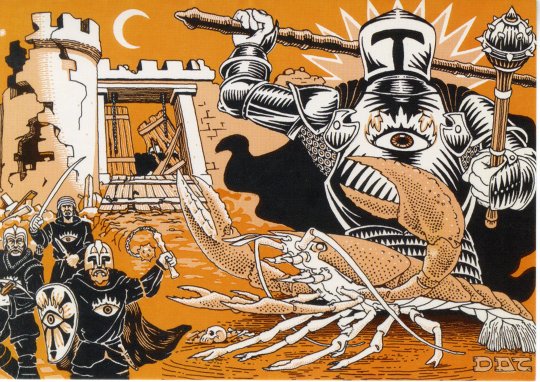
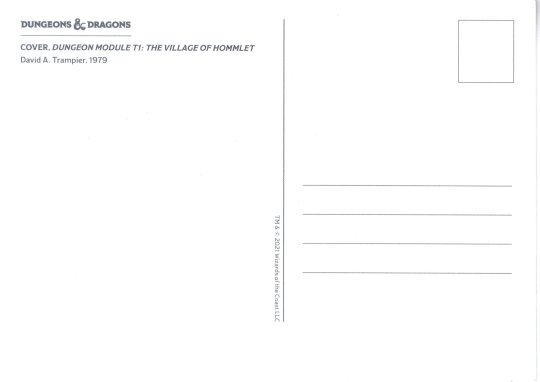
Dungeons & Dragons Dungeon Module T1: The Village of Hommlet David A. Trampier, 1979
#postcard#post card#postcards#post cards#d&d#dungeons and dragons#d&d illustrations#david a trampier#1979
26 notes
·
View notes
Text
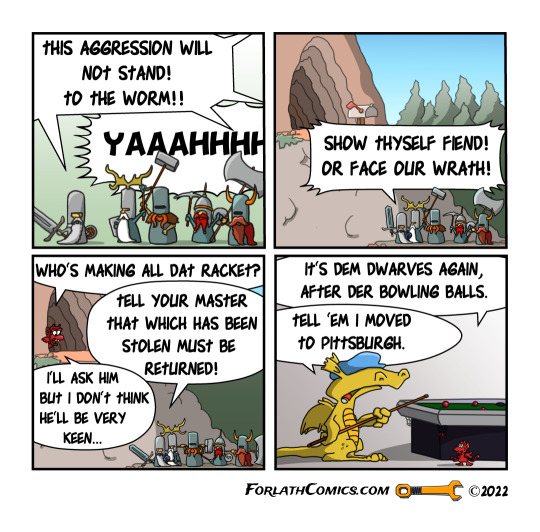
Wormy tribute. David A. Trampier, gone too soon...
0 notes
Text




Beautiful Decay
Everything drips eventually, except for the things that dried.
The image(s) above in this post were made using an autogenerated prompt and/or have not been modified/iterated extensively. As such, they do not meet the minimum expression threshold, and are in the public domain. Prompt under the fold.
Prompt: colorful splashes of color in an image, in the style of photorealistic pastiche, wlop, bio-art, majestic composition, high speed sync, poured, gutai :: an illustration of Cookie Monster, full body, pen-and-ink illustration, etching, by Russ Nicholson, DAvid A Trampier, larry elmore, 1981, HQ scan, intricate details
#paint splatter#drip#tw: trypophobia#tiny holes#unreality#midjourney v5.2#generative art#ai artwork#public domain art#public domain#free art#auto-generated prompt
21 notes
·
View notes
Text
No. 1 - G1, The Steading of the Hill Giant Chief (July 1978)
Author(s): Gary Gygax Artist(s): Erol Otus, Dave C. Sutherland III (cover), David A. Trampier Level range: Average of 9, preferably 5+ players Theme: Standard Swords and Sorcery Major re-releases: G1-3 Against the Giants, GDQ1-7 Queen of the Spiders, Against the Giants: The Liberation of Geoff, Dungeon #197, Tales from the Yawning Portal
I'm not sure if G1-G3 are the most remastered adventures of all time, but it's gotta be competitive. I think Tomb of Horrors might have it beat, but I haven't counted. The 4e conversion [the Dungeon #197 one] is really weird in particular because…4e feels like the edition least interested in the legacy of DND? It was boldly doing its own thing. A good quality, actually.
Anyway, it's time to slag off* on a beloved adventure. Note, I am using the earliest copy of G1 I can find, which is from waaaay later when D3 was complete. I apologize.
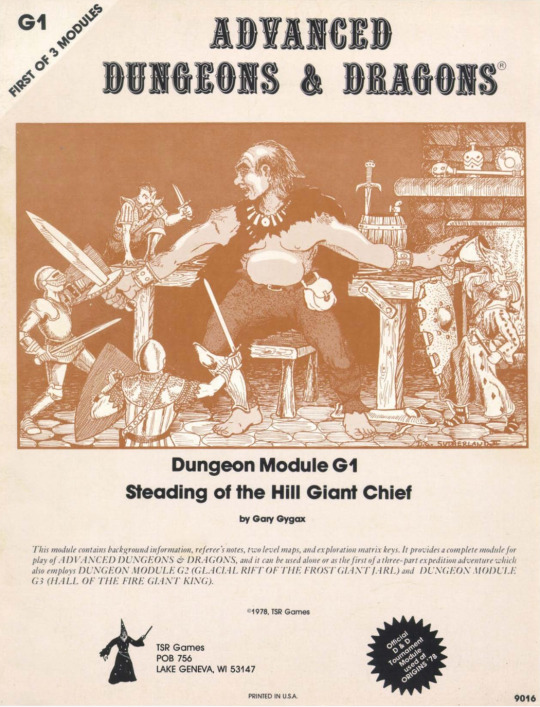
*And by slag off, I mean "be critical of at all". In practice, this module is actually showing some unusual acumen compared to its contemporaries.
EDIT: I forgot to mention a rather important thing when this was made live -- note the title there! We are officially in ADND land now, so put away your little brown booklets and switch over to the fuck-off awesome player's handbook with the iconic Moloch statue!
Somehow I had gotten my whole life at this point never really…understanding what this structure was supposed to look like? It looks like this.

I honestly think exterior shots of dungeons are critically underrated. Handouts are amazing and being able to flash the back cover art to safely show the party "like this" is actually great, I deeply wish that….any? of the previous modules had done that? I think the only one that did was Tsojconth. Weirdly, the interior drawing is very subtly different. Look at how the logs face:
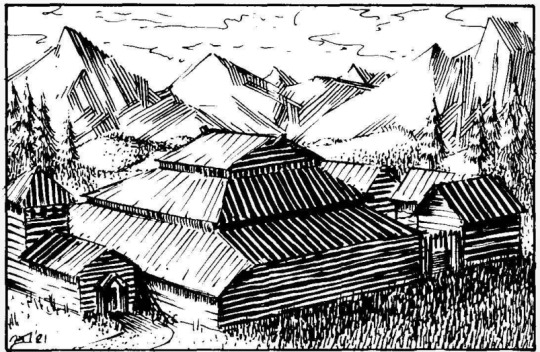
Not a huge deal but, a kind of weird inconsistency that top one looks like a stockade and the bottom one looks like a log cabin. Side note, we know that the long dimension of this is using 210 feet tall logs, which is to say, the size of an average redwood. These are some big fuck-off trees -- which could be a very interesting detail about the local area.
Now the setup is pretty simple. You were hired to go beat up the giants because they've been raiding the local humans, figure out why they're raiding, and comeback posthaste. The locals have kitted you out with horses, guides, maps, et c -- but no compensation, they have simply omitted a finder's fee (cheap bastards). Also, if you fail, they'll execute you. With friends like these, who needs Giants?
Gary starts with some mild railroading (you accepted the job already, you are already kitted out, you already walked to a nearby cave, you waited til dusk to approach, you notice two guards are missing, and the cave is guaranteed to be moderately hidden. Sure, whatever, I'm going to ignore that if I run this tho. Gary notifies us of a few critical details:
Don't run this stock, that's immoral
Any surviving giants will flee to G2 if they have the opportunity (which, kind of inherently punishes clever play that avoids combat?)
There is a 2% chance per round that the wooden structure will be lit on fire due to chronic rain (why is this a dice roll??)
If you will permit me a tangent, player arson is truly the bane of interesting scenarios everywhere. Whenever a player wonders, "why are all the GM's dungeons underground or in stonework buildings?", it's because doing anything else invites arson as the default and best answer to all problems. Magic items are fireproof and most metal items will not get hot enough to be destroyed, so very often the best solution is to burn the place to the ground and loot it the next day. So, yeah. No wood buildings. Gary's fix is to have all the giants flee into the basement, then waste a week of the PC's time for daring to use arson. Kind of sucks!
Tangent complete.
Here's some random interesting bits:
Gary explicitly states that you can pass yourself off as hill giant kids, which is extremely funny. Minus the implicit child murder.
Naturally there are giant moms doing giant housemaid shit in several rooms. Presumably they have giant curlers too.
The secret door is, literally just a doorway covered by a pelt. I have to hand it to them, that'd trip up most players in 2024 AND make them feel stupid for not figuring it out!
The big reveal that Eclavdra the Drow is secretly behind it all is so lightly teased that it feels downright tasteful.
A giant that uses a ballista as a crossbow (based) and spears for arrows (also based) -- between the prevalence of lightning spears and greatarrows, one starts to think of a certain famous video game. Genuinely I think it'd be a fun exercise one day, for someone who is more knowledgeable than me about Japanese fantasy roleplaying culture, to talk about how anglophone fantasy works made their way into Japan and were interpreted.
One of the cloud giants has hidden a sentient giant slaying sword that speaks all the giant languages, it feels like there's a hell of a story going on there that is only alluded to!

To my knowledge, this is the first official depiction of an orc in DND? Which implies that Gary is team pig-orcs, which is cool. Frankly, I love porcine orcs, or even better just pigfolk in general, they're great.
I think it is actually a rather bold early stance for Gary to hold that, even here in 1978, Chaotic aligned creatures are not automatically friends. Granted, that's how it is in Elric, so it's not THAT bold, but clearly everyone else missed the memo. The orcs are willing to side with you at least in the short-run, and in our previous modules it was very rare to have groups of chaotic-aligned creatures fighting one another. It was always just personal beefs. In fact, the overall theme of G1 so far is that despite the boxy-ass dungeon design, there's already a command of naturalism that even modern dungeons really struggle with. Factionalism truly is the gift that keeps on giving for the GM!
So the big reveal internally to G1 (just think of that -- a reveal internally to G1, and externally to the GDQ supermodule -- we're already getting pacing!) is that the orc slaves have rebelled. And -- hey -- good for them. There's also a kind of…built-in companion refill system going on here? So in oldish DND the way it works is, the expectation is the party is not just 5 guys with swords. You've got companions to help fight, and you've got hirelings to do other stuff (test suspected traps, if you're evil). And you can only hire so many of these guys from town, but attrition is going to happen. So the modules simply provides, automatic replacements should you negotiate worth a quarter of a shit. A dwarf slave here, an orc slave there. Maybe a giant dissenter if you're really clever. One of the potential "rewards" you can get is more dudes to throw at problems.
More interesting bits
There is, what I can only really call an abortive idea going on here where there's a scary temple in the basement? But no one worships there and no information is provided. It is merely a fucked up altar. I think I vaguely recall that it's retconned Tharizdun in one of the remakes? They always retcon things to be Tharizdun. Busy man, Tharzy.

Gary, Gary no. Stop it. Stop this 78 guys bullshit. I thought we had established that giant rooms of giant clumps of guys was bad. I know you have terminal Napoleonics brain but stop.

Wait, Steading is a noun? I always thought it was a verb. Yknow, like "Steading those hill giants", taking 'em down a notch. Apparently, a Steading is a small farm -- same etymology as Homestead. I guess mark that as our first Gygaxism?
Our second Gygaxism is gill, which is "a quarter pint of an alcoholic drink", which is to say a few mouthfuls

Always end your adventures with weird, ominous non-diegetic text. On the flip-side, absolutely do not do what the adventure does, and end on a teleporter that takes you to the next dungeon. That is the worst option.
Anyway, that's the whole Hill Giant situation. Honestly, it's better than I remembered, but in proud module tradition up to this point it gets weirdly filler-y in the basement. There's just something about basements that makes dungeon designers stop giving a shit, I swear. I do need to give the man his due, even though he was a shitass person: Gygax wrote an 11 page module that is of noticeably higher killer-to-filler ratio than any of his contemporaries. G1 is better than any of its predecessors, pound for pound. It is way, way shorter which is I suppose a plus to me and a minus to others, but -- there is a clear internal logic to this place that is tragically missing from (say) The Dwarven Glory. And that internal logic is the beginning of good adventure design. Anyway, we have two fun tidbits to discuss before we end for the day.
First up, we have an of-the-time account of events in Dragon #19! It turns out that in Origins '78 they played G1-G3's prototype. The account is of the winners (mostly West Virginians, a few Michiganders), who used their magic extremely liberally to hide what they were doing as well as to scout. They did opt to light the place on fire, good for them! If you want to check this out, it's on page 3. I will mention G2 and G3 here as relevant later.
Second up, there's a weird interquel hiding in Dungeon #198! Hanging out as an informal G1.5 is "The Warrens of the Stone Giant Thane!" I will not review it in full because my understanding of 4e is, basically just skimming the PHB and reading the DMG, but essentially the Stone Giants are hypothetically aloof and not particularly loyal to their Fire Giant superiors, but someone gave them The Rock That Makes You Crazy and so now they are. Smash the rock!
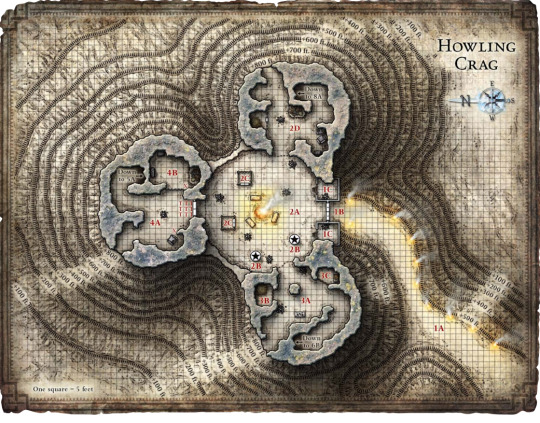
Man, map design in the 4e era was so fucking bad. It looks fine, but like, this is four circles. And downstairs is, of course, cave as far as the eye can see. Aren't stone giants supposed to be skilled carvers? Anyway, If you feel like G2 would be too big of a jump mechanically compared to G1, this exists. I'm sure you could use it if you liked, and certainly there is a Genre of Grognard who would be kinda tickled at the thought of finding "lost content" for el classico GDQ.
Next week, we cover G2, which was also in July. So was G3! They're triplets!
24 notes
·
View notes
Text
499.1. David A. Trampier, Bill Willingham and Erol Otus - Illustrations for GDQ 1-7: Queen of the Spiders (1986)




7 notes
·
View notes
Text
The End :(
So that was the last page of Wormy ever published before David Trampier's disappearance, reappearance, and eventual death in 2014. I hope everyone enjoys Wormy and remembers Tramp fondly.
#comic#dave trampier#dragon magazine#comics#dnd#fantasy#dungeons and dragons#wormy#1980s comics#1980s fantasy
5 notes
·
View notes
Text
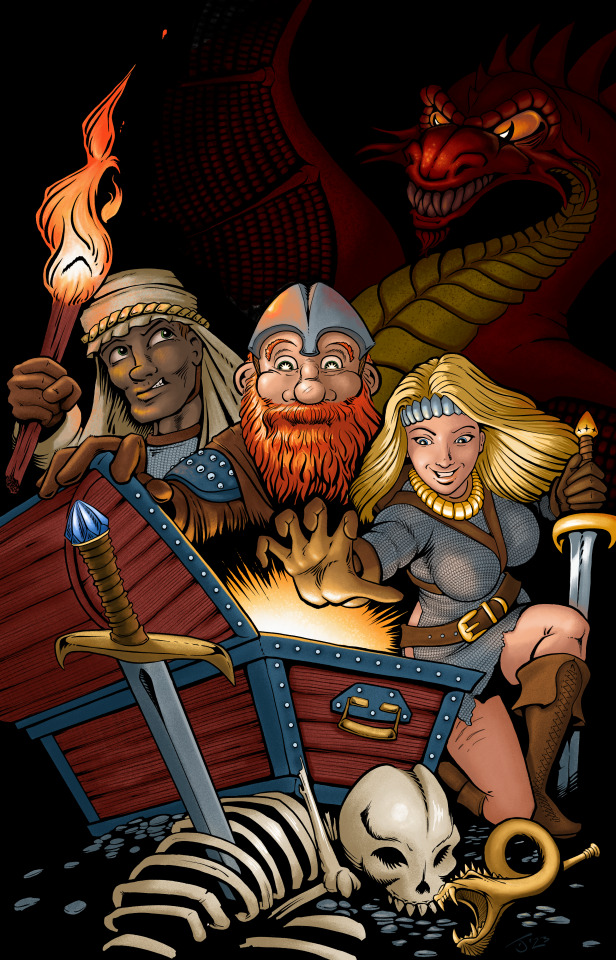
A pic I drew for my upcoming TTRPG Dragonhead.
It's a take on the classic treasure check pic by David Trampier from the AD&D players handbook
9 notes
·
View notes
Text
"When you look at the numbers presented in the report, they add up to a game that doesn’t take lives, but saves them."
1 note
·
View note
Text
Episode 801: David A. Trampier's "Wormy"
Greg kicks off The Someday Project looking at one of his early comics influences: a magazine-sized mind-bender (at least for someone of his age to read it) unlike anything else on the stands. HEAVY METAL? Nope. 2000 AD? Negative. Those are coming soon enough, but today Greg talks about the impact of David A. Trampier's "Wormy" from DRAGON magazine. Does it still hold up? How can you get a hold of it today? All that and more in today's episode!
SUPPLEMENTAL MATERIAL
The start of "WORMY" on the Internet Archive
"Wormy" ran in DRAGON issues:
9-20
29-34
36, 39, 42-44
47-52
54-58
60-128
130-132
Wormy: The Dragon's Dragon
Correspondence with Dave Trampier and A History of His 1985 Attempt to Crowdfund a "Wormy" Anthology
__________
Robots From Tomorrow is a comics podcast recorded deep beneath the Earth’s surface. You can subscribe to it via iTunes, through the RSS feed at RobotsFromTomorrow.com, or on the show's YouTube channel. You can also follow Greg and the show on BlueSky. Stay safe and enjoy your funny books.
Check out this episode!
0 notes
Text
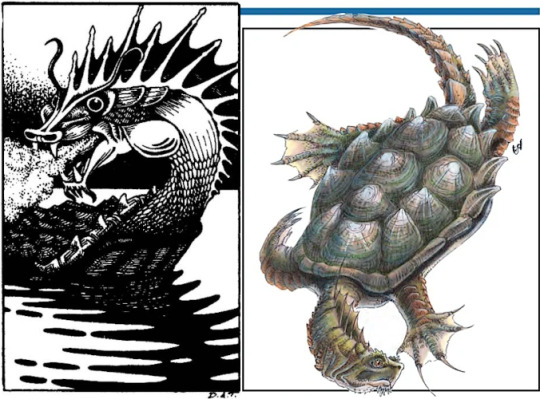
Inspired by Chinese mythology, the Dragon Turtle first appeared in D&D in 1974's The Underworld & Wilderness Adventures (where it was claimed to be the "most fearsome monster of the waters"). They can be a shell of a good time for players to encounter but don't get them steamed or they'll wreck a ship quick… on THAC0 Thursday!! Art Left: David A. Trampier Right: Tony DiTerlizzi
1 note
·
View note
Photo

Game night! David A. Trampier, “Magic Mouth.” Illustration for AD&D 1st Edition Player’s Handbook (TSR, 1978).
__________________________________________________ Our shop: https://bookshop.org/shop/manyworldspress
#david a. trampier#trampier#magic mouth#dungeons & dragons#advanced dungeons & dragons#player’s handbook#gary gygax#tsr hobbies#dungeon crawl#fantasy art#game art#game night
114 notes
·
View notes
Text



Tessellating Beautiful Decay
Each tiles infinitely, for use in wallpapers and the like.
The images above in this post were made using an autogenerated prompt and/or have not been modified/iterated extensively. As such, they do not meet the minimum expression threshold, and are in the public domain.
Prompt: colorful splashes of color in an image, in the style of photorealistic pastiche, wlop, bio-art, majestic composition, high speed sync, poured, gutai :: an illustration of Cookie Monster, full body, pen-and-ink illustration, etching, by Russ Nicholson, DAvid A Trampier, larry elmore, 1981, HQ scan, intricate details --ar 3:4 --s 50 --v 5.2 --tile
#abstract blobs#wallpaper#i artwork#deepSCREAM nights#halloween#unreality#midjourney v5#generative art#public domain#public domain images#free art
48 notes
·
View notes
Text
No. 9 - T1, The Village of Hommlet (August 1979)
Author(s): Gary Gygax Artist(s): David A. Trampier (Cover), David C. Sutherland III Level range: 1 Theme: Tutorial dungeon Major re-releases: T1-4 The Temple of Elemental Evil, The Village of Hommlet (2009), Original Adventures Reincarnated #6.
CW: Discussion of Antisemitism. I didn't see that coming.
Possibly the end of the hiatus curse? Since then, I had further brainworms and acquired (and read) the fiend folio, the MM2, several Jon Petersen histories on TSR and the industry, and more. Will this reflect in the review itself? Maybe!
...Wait, there's a 4e version? 4e had a really weird habit of random 1e remakes didn't it? It was a reward for WOTC's organized play DMs, I have not read it in its entirety but it is very revisionist in a bad way. It's jarring, it mashes up 4e-style art with the original black and white pen-drawn art of 1e and also greyscale realistic maps? It's a mess of a release and there's some truly weird retcons in it. Anyway, we're here for 1e, not 4e.
Actually, one more aside. There is an adventure sequence called The Great Greyhawk Campaign. It was never officially announced or released as one product, but the idea goes that you start in Hommlet, you go to the Temple of Elemental Evil, you do the Slavelords campaign, then the Giants sequence, then the Drow sequence, and finally wrap in Q1. That's a hell of a ride, and it would probably comfortably get you to level cap for most characters. I really wanna try it some day, but I can't imagine it ever happening (that is SO long!)
So. T1. How do you start with T1?
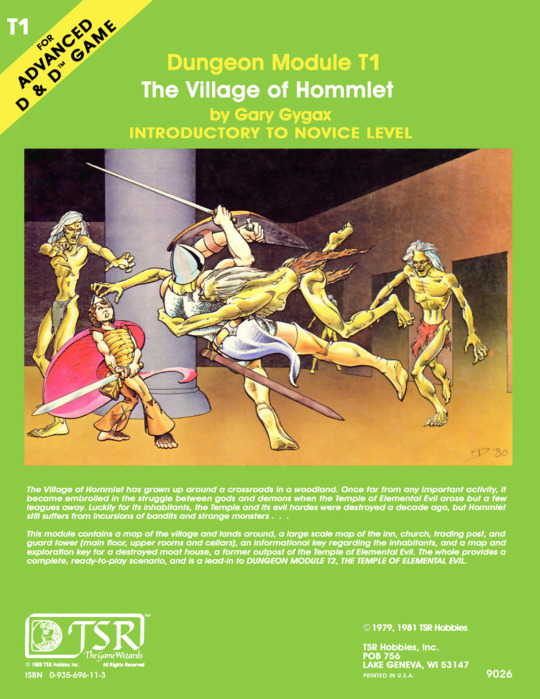
I think you can seriously argue that T1 is the single most reviewed module of all time. It honestly feels a little excessive to cover it. And yet, I felt obligated to do my dues to T1. Why?
Because T1 is, more than any previous module, the most influential module ever made. Lots of early modules are influential. G1 is important for being the first standalone module. D2 is important for being an early module to not assume hostilities. B1 is the first tutorial dungeon. But the thing about all of those is that in 2025, those types of modules have dramatically moved on. T1 remains the same. T1 is the granddaddy of all starter towns in every video game and every ttrpg. Every starter town is being compared against T1, it is the baseline.
Now this is not to say that T1 is perfect, or that T1 has aged like fine wine. But T1 tapped into something elemental about D&D that it needed to progress. Prior to T1, many parties simply...didn't play out the out-of-the-dungeon part. Characters poofed into the dungeon entrance and poofed out because the game was about dungeoncrawling. T1 represents a wildly different vision for the game, one that Gary and friends had been doing for a while and many people had independently dreamed up, but T1 made it standard that there was a nearby town that you actually went to and played things out, that was your home base. D3 was still, ultimately, a hostile environment. Like look at this:

That's just what DND towns look like. This basic structure (a town with a mayor and farmers and shopkeeps and blacksmiths and the local wizard and a dungeon nearby) is ubiquitous in DND now. You can basically describe any given dnd starting town as Hommlet And BLANK. Orlane is Hommlet And Kidnappings. Phandelin is Hommlet And Miners. Shadowdale is Hommlet And Wizards. Saltmarsh is Hommlet And Smugglers. It's hard to even get across how little has fundamentally changed between T1 and the 2014 Starter Set. Really if one thing has "changed" between T1 and then, it's the belief that adventures SHOULD have narrative hooks and SHOULD have an overarching plot. Even then they sometimes skip those.
Despite it's influence, T1 is weird in that it feels less like a module and more like a game aid. At its core, Hommlet is a town that has nothing to do with the nearby dungeon, and a dungeon that has nothing to do with the town. The town is keyed like a dungeon, and the dungeon is keyed like...a dungeon. The connective tissue is that the Temple of Elemental Evil is lurking as a threat behind everything, but T4 won't be released for QUITE some time, so it feels vague and distant. We get an actually surprisingly sophisticated history lesson: Hommlet was founded as a travel inn, a blacksmithy, and some farms. It grew into a proper town. Things got bad when their neighbors in Evil Town decided to Worship Evil and did Evil Stuff to them. The forces of good rallied and killed the bad guys, sieging the Temple of Elemental Evil and locking the evil inside. Adventurers slowly dried up as the area ran out of adventure to adventure at. So now evil returns and you lot will bumble into it.
Let us, then, get into the town part of the key.
One of the cliches of old TSR towns, to me, is that item #1 is always a farm. The game always presumes you enter town and you find a farm and the family is there and they wave at you. Orlane inverts this a bit by having the farmers NOT happy to see you, which is one of the many reasons I consider Orlane to be the most interesting starter village ever.
At this point time, thieves are a class now, and so (conspicuously) everything is marked for how the players could rob it.
There are a lot of what you might call "empty hooks" lying around town. For example, the son of a local farmer is actually a spy for Verbabonc (SUCH a TSR name) that will help you if paid to, and if he dies his brother will demand restitution. Why? That's left to a later module! Which wouldn't come out for another 6 years! Oops!
The wealth amounts in this town are genuinely unhinged, as usual. Inside a crock in some cowshit is, for some reason, nearly 700gp of treasure. Would you go digging around in cowshit for 70 dollars? Maybe if I had gloves. The placements are all nefariously difficult here: "sewn inside a horsecollar" do kids even know what horsecollars are anymore? Do they know who Horace Horsecaller is? How old are we!
A frankly annoying quality here is that these buildings are keyed with the first appearance in ALLCAPS followed by the actual building title in the body paragraph -- The Inn of the Welcome Wench is buried 3 lines into its text. You're not gonna skim that. You have to know in advance where it is, basically. The inn itself is, inexplicably, keyed separately without calling out that the actual room-by-room is elsewhere. If you scroll forward to page 9 (possibly looking for the map, which is also housed elsewhere), The contents of the inn itself is fairly ho-hum, it's a normal inn with many normal recruitment opportunity and the obligatory gygaxian traitor henchmen (who are unfailingly higher levels than their non-traitor peers). A few specialties are here though: a secret room from the old resistance, a spy from the temple of elemental evil, a secret ceiling compartment where druids can spy on suspicious guests).
A cavalcade of repetitive cottagers follow, emphasizing why in the future we stopped keying every single house. Many are not named, with that classic "so you customize it" excuse that people love trotting out. It does serve the purpose of making sure you have an answer to exactly who is with which faction: The Cuthbertites, the newbie; The Grove, part of the old alliance; the Temple, Verbabonc, the big supporter of the alliance; or one of the few neutrals.
The trader's establishment is also lovingly given a map and keys. Curiously, it is for lack of a better phrase "sub keyed", where the main room has every single item in it given a location. The map is here mainly because the players might discover the traders are also spies and want to kill them. They probably won't succeed, it's a Lv10 thief and a Lv7 assassin, they will at best cause them to flee and at worse die in the process.
I always find it funny how "moneychanger" is a perpetual occupation in DND. I have no idea how common historical moneychangers were, but if DND is to be believed, there's one in every podunk town. What do they do for the majority of the year when it's not market day?
For reasons I cannot fathom, they finally call out the separate map and key for the church after skipping every other keyed location. It's a standard fantasy church, styled after a catholic one, with the bit that Cuthbert is a brute and likes beating his worshippers into compliance. It's trying very hard to be funny but I'm not sure how funny it'd be to any table I've run. Why precisely this needed a room by room map is unclear to me, I can't foresee why you'd fight there. The walled manor is not keyed, despite being the official holdout if the temple attacks.
A half-built castle is underway for the town's old heroes, Burne and Rufus, who are mid level adventurers who have settled down. They live next door in the tower, which gets its own key, though there's not much to report beyond "it's a guard tower." Really, the main advantage of T1 as a document is that it has maps for your default buildings: a town, an inn, a trader's shop, a guard tower, and a dungeon. The maps are probably worth more than the keying for the purposes of the neophyte GM.

It is truly the town-est town ever to have town'd. Its genericity means you really could just put it in any faux medieval fantasy setting anywhere.
Nothing's really driving you to the main dungeon, that moathouse, in fact it never directs you to mention the moathouse from any specific NPC. You either work it in or the players need to wander around and explore it for simply being there -- like you're playing a TES game. In fact, not much of this book's setups really fire off anything else. There are a few people who will tail you into the dungeon or betray you if you hire them to go in with you, but that's pretty much it. All the actual secret going on in this town is immaterial to T1, setting up for T4? But let's talk about the moathouse.
First of all, I just adore the bad guy's name. "Lareth the Beautiful." They really don't make NPC names like they used to. A good title after a first name -- even just a place of origin name (Bridgette of Freeport) starts implying things about the world that are far more interesting that Jane Silvercat. A pox on noun-noun names! It's almost a shame Lareth will probably die here because he begs to be put to greater use! In any event, the Moathouse is a shithole. Just look at this mess:
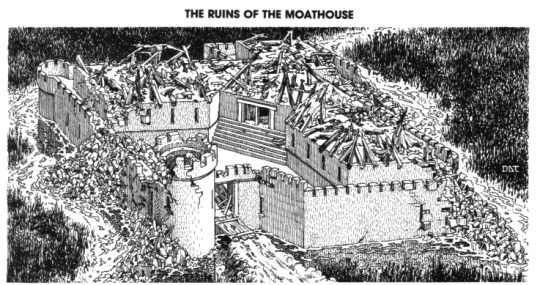
Your first instinct when you're reading about the new castle is "why don't they just repair the moathouse?" and you see this mess and you go "oh yeah that makes sense." There's not much to say: it's a moathouse the Temple of Elemental Evil built as an outpost. It got destroyed when the Temple got shut down by the big alliance, and now it's despised and destroyed. It's faintly defiled land. Really the weird thing is that it's a full hour away in a marsh. I will spare you the Monty Python bit.
Going into the keying now:
The random table is interesting in that half of the encounters are actually not encounters at all, but rather random happenings. It's a messed up castle so it's echo-y and there's rats and it's still in the process of falling down.
There's something so simple about being jumped by frogs at the front gate. I always love the "drag the player by the frog's tongue" moment and I use it often in my own games.
This dungeon is working hard to communicate how messed up it is. Even the floor will give in on your mount, laming them. Mercifully, there's a chance of discovering bootprints to confirm you're not alone.
The bandits inside have a solid escape plan, and will use it if you look scary: bar the door and run through the hole in the wall into the marsh. It's nice to see clever bandits sometimes.
Not unlike Saltmarsh later, the top level is mostly deserted. It exists to get you off guard for the actual danger in the dungeon level. Physically accessing the basement is fairly easy, there is 1 access that you simply walk into from the big room, although a sister staircase gives you further reason to look for it.
The bottom level, by comparison, is just very stereotypically dungeon-y. There's torture chambers, miscellaneous monsters there through hiring or chance, torture chambers, et c.
The false door trap is so beautifully simple that I'm a little surprised it hasn't made more returns. Essentially a common door that, when opened, closes a portcullis behind the door and reveals a dead end on the other side. It's basically just a loud cage snapping shut. So many traps make no sense but this one is surprisingly simple: it's a gravity powered trap, controlled by a disguised winch elsewhere.
Tragically, Lareth's ambitious do not get much detail. He's the new hope of the Elemental cult but how or why he does this is not clear, just that he's underhanded and clever.
A strange and gross final note to end on: one of his pieces of loot is a phylactery, but not in the Lich sense -- it's an amulet-amulet. That you wrap around a cleric's arm. In fact, Lareth is specifically wearing it on his left arm, which strongly implies he's right-handed. I think this because, when Jewish folks wear real-life phylacteries, they wrap them around their non-dominant arm, and another around their head. Wait, so we have an evil cleric leading a secret cabal that is opposing a catholic saint by spying and infiltrating a community and leading monsters against them, and he is explicitly duplicitous and a talker and underhanded and greedy and in league with a demoness. The fact that Laerth is wearing the phylactery correctly implies that Gary knew exactly what it was. Gary, why did you strongly imply the evil cleric in charge of the evil cult of demon worshippers was Jewish? Gary, what the actual fuck? In hindsight, the bad jokes about Cuthbert scan as an inquisition joke, I was imagining a nun smacking a student with a ruler...
That's...a really bummer note to end on. I'm sorry. Next time, uh...White Plume Mountain, the funhouse dungeon? At least it'll be lighter...
5 notes
·
View notes
Text
42. Gary Gygax - Monster Manual (1977)

The first of what would become a DnD institution with every edition and also the first publication by TSR tagged as Advanced Dungeons & Dragons, the First Edition Monster Manual is as would be expected a list of monster that can appear during D&D games and that you can use to populate your dungeons, now handily contained in a single volume, instead of spread around several magazines, brochures and supplements as was the case in Original D&D.

This is a lot heavier on the mechanics and general description of the monsters than on lore. There was actually little lore at the time, most of the unique creatures would come from the Greyhawk or Blackmoor settings that were the home games of Gygax and Arneson, that where the Demogorgon or Orcus are coming from, for example. So there's a general description as well as attack stats and so on.
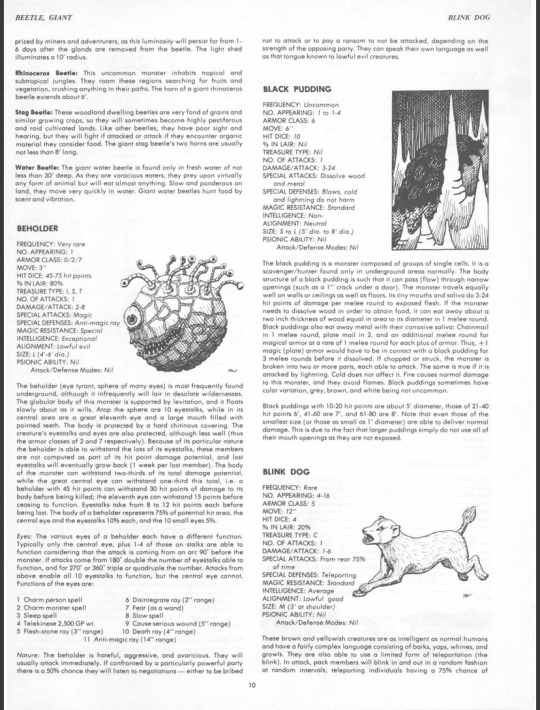
By far the best thing about this edition, however, are the 350 illustrations included, which would have a life far longer than the edition itself. By the early 90s, the SSI D&D Gold Box video games would still be basing their graphics off many of the images that started out here, and this also gives us some of the first truly great D&D art. Other than the famously funny looking Beholder here you get a lot of art signed DAT, meaning David A. Trampier, and his stuff is amazing, his line drawings with thick black outlines would make for some great tattoos if anyone's interested. DAT also had a fascinating life, eventually disappearing without a trace for years. Really worth taking a look at.

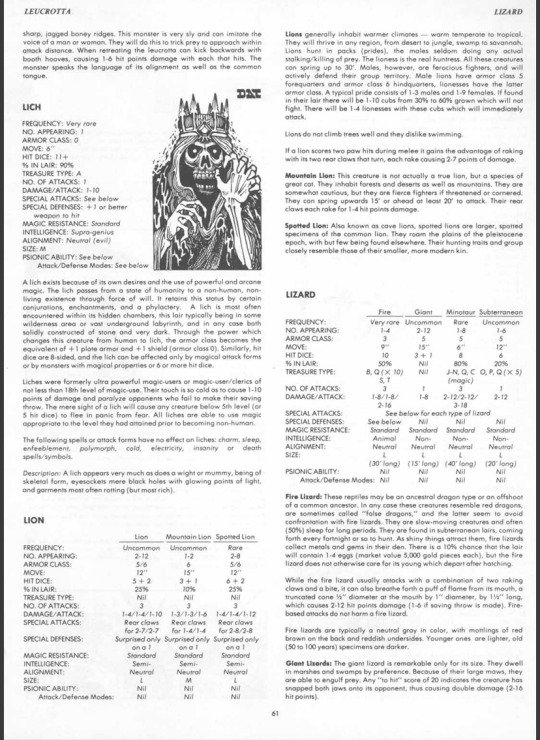

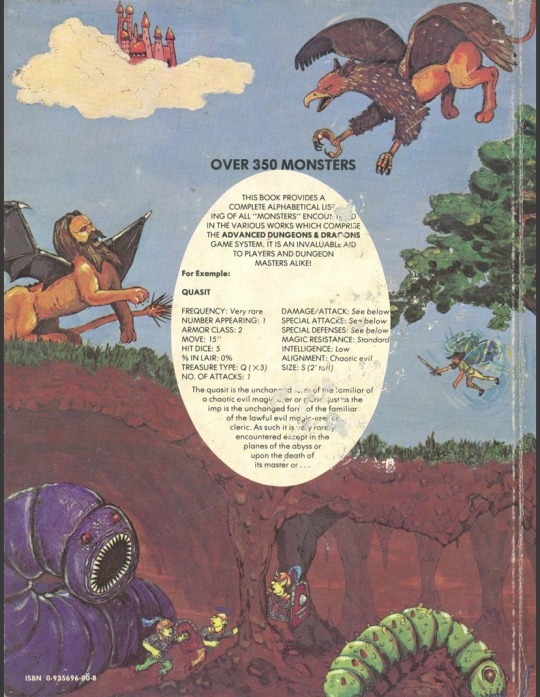
32 notes
·
View notes
